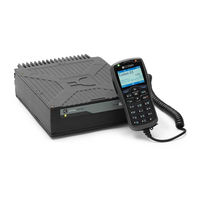User Manuals: Codan Envoy HF Radio
Manuals and User Guides for Codan Envoy HF Radio. We have 4 Codan Envoy HF Radio manuals available for free PDF download: Reference Manual, Getting Started Manual, Control Getting Started Manual, Manual
Codan Envoy Reference Manual (537 pages)
RADIO COMMUNICATIONS
Brand: Codan
|
Category: Transceiver
|
Size: 22 MB
Table of Contents
-
Introduction
25 -
-
-
Calling67
-
Using GPS95
-
Finding an RFU109
-
Menu Structure112
-
Moving a Slider131
-
Channels
139-
-
Channel Name141
-
Frequency141
-
Modes142
-
Preferred Mode142
-
Power142
-
Antenna143
-
-
-
Adding a Channel145
-
Moving a Channel148
-
-
Scan Tables
150 -
HF Networks
162-
-
HF Network Name164
-
Call System164
-
Self Address165
-
Scan Tables165
-
Global166
-
Preamble166
-
Privacy Mode167
-
Privacy Password168
-
Rx Only168
-
-
Phone Links
174-
-
Phone Link Name175
-
HF Network175
-
-
Contacts
179-
-
Contact Name182
-
HF Network182
-
Call Type182
-
Phone Link183
-
Phone Number183
-
Call Description184
-
Base184
-
-
Nets
197-
Overview of Nets198
-
-
NET Name200
-
Address200
-
HF Network200
-
NET Members201
-
Out Calls201
-
In Calls201
-
Link202
-
Response203
-
Tune Time203
-
LQA Exchange203
-
Slot Width204
-
-
-
Adding a NET205
-
Editing a NET208
-
Moving a NET208
-
Deleting a NET208
-
-
-
Peripherals
213-
-
RFU 15Way Mode219
-
RFU 15Way Speed220
-
RFU Average ALC220
-
RFU ALC Rate220
-
RFU Audio Type220
-
Rfu Agc221
-
RFU PTT Beep221
-
RFU Mute Extend221
-
RFU Secure Audio222
-
RFU Quiet Line222
-
RFU 6Way Mode223
-
RFU 6Way Speed223
-
RFU 6Way Startup223
-
-
Settings
225-
-
Welcome Image227
-
Welcome Text228
-
USB User Access228
-
Channel Scroll228
-
Frequency Format229
-
Call Key Options229
-
-
Brightness231
-
Auto DIM Time231
-
Key Beeps231
-
Beeps and Tones232
-
Theme232
-
Night Theme232
-
Logging233
-
Logging Level233
-
-
Status Area 1234
-
Status Area 2234
-
Status Area 3235
-
Status Area 4235
-
Status Area 5235
-
Status Area 6235
-
-
-
Time Zone237
-
Daylight Saving237
-
Clock Type237
-
Time Format237
-
Date Format238
-
-
-
Console Location239
-
Internal Speaker239
-
Console PTT240
-
Foot-Switch PTT240
-
-
-
Admin PIN241
-
Noise Limiter241
-
Power down Time242
-
Easitalk Mode242
-
RF Pre-Amp242
-
Tx Power243
-
Low Power243
-
Medium Power243
-
High Power244
-
Default Selcall244
-
Handset AGC244
-
Handset PTT Beep245
-
Morse Timeout245
-
PTT Timeout245
-
Units246
-
Abandon Mode246
-
Command Line246
-
RFU Logging246
-
-
-
RFU Secure Audio248
-
-
-
RFU 6Way Speed249
-
-
Settings > Scan250
-
Auto Resume Mode250
-
Auto Resume Time250
-
Scan Mute251
-
-
-
External Alarm254
-
Alert Tones255
-
Call Status Time255
-
Chain Call Pause255
-
In Call Timeout256
-
LBT Mode256
-
LBT Period257
-
LBT Waveform257
-
Respond GPS258
-
Respond OTA259
-
-
ALE LQA Average261
-
ALE LQA Decay261
-
ALE Site Manager262
-
ALE AMD Position265
-
Ale Ber266
-
ALE Call Scan266
-
ALE Scan Cycles267
-
ALE Golay268
-
ALE LQA Exchange270
-
ALE LQA Mapping270
-
ALE Retries270
-
ALE Silent Mode271
-
ALE Soundings271
-
-
Settings > GPS272
-
Settings > Audio275
-
-
CES-128 Mode276
-
Privacy Code276
-
General Options278
-
CES Options278
-
CES Key Prefix279
-
-
-
IP Address280
-
Alias280
-
Network Mask280
-
DHCP Client281
-
Default Gateway281
-
USB IP Address281
-
USB Network Mask281
-
USB DHCP Server281
-
RFU IP Address282
-
RFU Alias282
-
RFU Network Mask282
-
RFU DHCP Client282
-
-
-
Access Rights
283 -
Keys and Macros
286-
Keypad287
-
Macros290
-
-
Adding a Macro293
-
Editing a Macro298
-
Moving a Macro299
-
Deleting a Macro300
-
-
Available Modes304
-
Table 11: Modes304
-
Free Tune
305 -
Data Options
320-
Data331
-
G Data Call334
-
Modem336
-
Encryption
339-
Using Encryption343
-
-
Secure Mode363
-
-
Standby Mode368
-
Base Key372
-
-
-
Fan Connector386
-
RF Connector386
-
10-Way Connector387
-
-
USB Connector397
-
8-Way Connector398
-
Specifications
402
Advertisement
Codan Envoy Getting Started Manual (219 pages)
Brand: Codan
|
Category: Transceiver
|
Size: 51 MB
Table of Contents
-
Introduction
14 -
-
-
Calling59
-
-
Using GPS87
-
Data Options98
-
Using Encryption115
-
-
Firmware Version133
-
-
-
Moving a Slider178
Codan Envoy Control Getting Started Manual (197 pages)
Brand: Codan
|
Category: Transceiver
|
Size: 4 MB
Table of Contents
-
Introduction
13 -
-
-
Calling61
-
-
Using GPS87
-
Data Options97
-
Using Encryption112
-
Adding a Contact130
-
Advertisement
Advertisement



